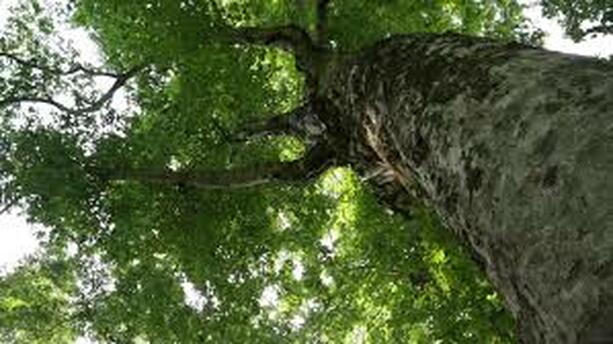 Invasive Kudzu Invasive Kudzu Invasive species upset the delicate balance of natural ecosystems. They disrupt food chains, destroy nutrient-providing resources, and overwhelm native species. Though invasive creatures can be introduced by storms and climate shifts, more frequently they are introduced by humans. As our world becomes increasingly globalized, it can seem close to impossible and perhaps futile to attempt to eradicate invasive species. Yet, responding to them is necessary. New York City is particularly vulnerable to invasive species as an international city. Visitors arriving from around the world sometimes accidentally carry seeds lodged in the soles of their shoes. Cargo ships inadvertently carry other stowaways. A number of invasives can be found in our parks. Tea Crabapples, a native of China is found in woodlands such as Central Park's North Woods and has been described as "the little apple that ate the Big Apple without careful management". Japanese Knotweed, grows so rampantly that it can crowd out other, more desirable plants. English Ivy wraps around tree branches, making it more difficult for native trees to receive the sunlight they need to grow. As with natural ecosystems, the delicate balance of a nation can be upended by hostile intrusions. Such attacks can require aggressive responses, at great sacrifice. On Memorial Day we honor those who gave their lives protecting and defending our country and its allies from militaristic threats and intrusions. We pay tribute to their courage and sacrifice and the unfathomable loss felt by their loved ones.
0 Comments
 I am a restless person. Left to my own when confronted with free time I like to go elsewhere, to get away and explore places near and far, other countries, other landscapes, other neighborhoods, and I am fortunate that circumstances allow me to do so. Restlessness has had its rewards. It has introduced me to different people and cultures, to new perspectives and has broadened my sense of natural and human history and activity. At the same time, it can take a lot of resources to be on the go, including time, money, and pollution-emitting carbon. Through hiking, exploring and guiding forest therapy walks, I spend much time in the presence of trees, pausing to take in their presence, to notice their form, and to contemplate their lives. Unlike animals, trees can't run away from their predators. They live their entire existence, sometimes hundreds of years, in one place (200 years in the life of a tree is the equivalent of 40 human years). Not able to run away or fight with tooth and claw, they carry their own medicine and systems to ward off danger. There's a reason so much of our medicine derives from plants: Imagine what trees have witnessed over the years as their trunks grow tall and thick and their branches reach skyward! Of course, trees are hardly still. From large vascular systems transmitting xylem and phloem to micro-activity on a cellular level, there is much movement, even if it isn't always visible to us. Yet, other than through the disbursal of seeds, trees are not mobile, whereas we are. As a human, I am animal, with muscles and limbs that enable me to ambulate and senses that enable me to to be drawn to what I need or to turn away from what is unpleasant or dangerous. This way of being is as central to me as it is to any other creature in the animal kingdom. Yet there is much that trees can teach us. Lately I've been thinking a lot about tuning in from time to time to a tree's perspective and the lessons to be learned. Without the impossible task of abandoning my animal self, maybe there is something to be said for staying more local, for standing tall while the activity of the world happens around me. What lessons would I absorb? What powerful medicine might I generate from such a stance? I recall the snarky word play, "Make like a tree and leave!" Cute, maybe, but what a brusque and inapt dismissal of our botanical, oxygen-providing neighbors on which we depend. Maybe it's time we "Make like a tree... and stay."  They stand tall, nurturing their offspring to enhance their chances of growing steadily and sturdily. They support their neighbors, transmitting messages across vast and intricate networks to ensure the community’s safety and well-being. They have withstood the cycles of many years, including challenging conditions, yet persist with grace and beauty. They are mothers – mother trees. Much attention has focused lately on the networked nature of forests. Trees exist not simply as individuals but within a highly collaborative, interconnected system, communicating through elaborate circuitry of fungi and root tips. "Forests", notes forester Peter Wohlleben in The Hidden Life of Trees, are superorganisms with interconnections much like ant colonies" Key to this interconnectedness are "Mother Trees", a notion pioneered by Scientist Suzanne Simardin (who appears as a fictionalized character in Richard Powers' The Overstory, the subject of the prior blog). The dominant trees in forests, Mother Trees function as central nodes for extensive underground networks of roots and mycorrhizal fungi. They nurture young trees by spreading fungi to them and conveying needed nutrients. Mother Trees also restrain the unfettered growth of young trees so that they can grow in ways that make them sturdier and more resilient.Writes Wohlleben: " Young trees are so keen on growing quickly that it would be no problem a all for them to grow about 18 inches taller per season. Unfortunately for them, their own mothers do not approve of rapid growth. They shade their offspring with their enormous crowns, and the crowns of all the mature trees close up to form a thick canopy over the forest floor. This canopy lets only 3 percent of available sunlight reach the ground and, therefore, their children's leaves. Three percent--that's practically nothing. With that amount of sunlight, a tree can photosynthesize just enough to keep its own body from dying. There's nothing left to fuel a decent drive upward or even a thicker trunk .... [S]low growth when the tree is young is a prerequisite if a tree is to live to a ripe old age. ... Thanks to slow growth, their inner woody cells are tiny and contain almost no air. That makes the tree flexible and resistant to breaking in storms." Slow growth also makes trees resistant to disease-bearing fungi,, which has difficulty penetrated the their tougher trunks. In the meanwhile, over a period that could last 200 years (the equivalent of 40 human years), the Mother Tree passes along sugar and other nutrients to the offspring. "You might even say they are nursing their babies," notes Wohlleben. Thanks to the attentiveness of Mother Trees, young trees can grow up strong and resilient, and forests can thrive. The same can be said for the roles of mothers (and fathers) within human families and communities. On this Mother’s Day, consider the Mother Trees around you.  New York is the epicenter of the book publishing industry. So, in exploring NYC nature connections it is apt to note the 2019 Pulitzer Prize for fiction awarded to Richard Powers' The Overstory, a novel in which trees shape the lives of nine characters and are so vividly evoked as to be characters too. In addition, Victoria Johnson's American Eden was a finalist for the Pulitzer for history. American Eden is a riveting biography of David Hosack, visionary physician and botanist during the early Republic who created the New York's first botanical garden (more about this terrific book in a later blog). Nature certainly received much attention from this year's Pulitzer Prize Board. The Pulitzer Prize Board describes The Overstory as "An ingeniously structured narrative that branches and canopies like the trees at the core of the story whose wonder and connectivity echo those of the humans living amongst them."....a sweeping, impassioned work of activism and resistance that is also a stunning evocation of—and paean to—the natural world. From the roots to the crown and back to the seeds, The Overstory unfolds in concentric rings of interlocking fables that range from antebellum New York to the late twentieth-century Timber Wars of the Pacific Northwest and beyond. There is a world alongside ours—vast, slow, interconnected, resourceful, magnificently inventive, and almost invisible to us. This is the story of a handful of people who learn how to see that world and who are drawn up into its unfolding catastrophe." With stirring, incisive descriptions, Powers awakens deep, limbic understanding of humans' biological and emotional connection to the natural world and the primacy of trees. “This is not our world with trees in it" he writes. "It's a world of trees, where humans have just arrived.” And what lessons there are to be learned from trees. Here's a passage I particularly like, one that portrays survival of the fittest not as fierce drama played out through competition among individuals but rather as a result of successfully networked, interrelated, and cooperative communities: "The things she catches Doug-firs doing, over the course of these years, fill her with joy. When the lateral roots of two Douglas-firs run into each other underground, they fuse. Through those self-grafted knots, the two trees join their vascular systems together and become one. Networked together underground by countless thousands of mile of living fungal threads, her trees feed and heal each other, keep their young and sick alive, pool their resources and metabolites into community chests.... Her trees are far more social than [she] suspected. There are no individuals. There aren't even separate species. Everything in the forest is the forest. Competition is not separable from endless flavors of cooperation. Trees fight no more than do the leaves on a single tree. It seems most of nature isn't red in tooth and claw, after all." There is much to learn from trees. |
About this Blog
Hi! I'm Nancy Kopans, founder of Urban Edge Forest Therapy. Join me on an adventure to discover creative ways to connect with nature in your daily life, ways that are inspired by urban surroundings that can reveal unexpected beauty, with the potential to ignite a sense of wonder. Archives
April 2023
Categories
All
|

 RSS Feed
RSS Feed